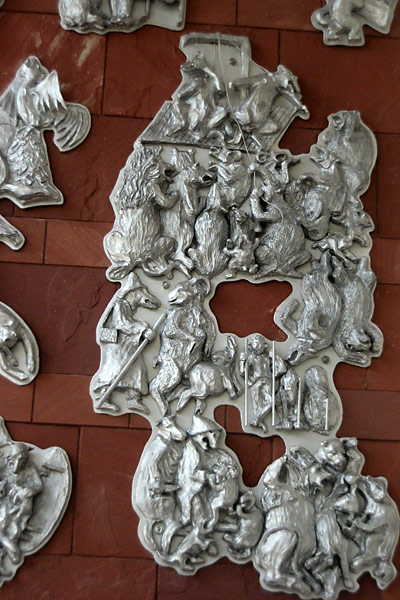

The characters of Reynard the Fox were based on the medieval hierarchy, and are treated as human throughout the tales. The given names of the animals are of Old High German origin most of them were in common use as personal names in medieval Lorraine. The main characters are anthropomorphic animals. Rare Book & Manuscript Library University of Pennsylvania Ms. Characters Defaced Reynard preaches to a rooster. While the authors take many liberties with the story telling, not all of the satire is meant to be rude or malicious in intent. The tales, no matter where they take place, are designed to represent the society around them and include the structures of society around them such as a noble court. However, the tales of Reynard come from all across Europe and each retelling has details that are specific to its area. The original copies were written in Old French, and have since been translated into many different languages. The trickster fox, Reynard, lives in a society of other talking animals (lion, bear, wolf, donkey, et cetera), making the stories a beast epic. While the character of Reynard appears in later works, the core stories were written during the Middle Ages by multiple authors and are often seen as parodies of medieval literature such as courtly love stories and chansons de geste, as well as a satire of political and religious institutions. His main enemy and victim across the cycle is his uncle, the wolf, Isengrim (or Ysengrim). His adventures usually involve his deceiving other anthropomorphic animals for his own advantage or trying to avoid their retaliatory efforts. The stories are largely concerned with the main character Reynard, an anthropomorphic red fox, trickster figure. The genre was popular throughout the Late Middle Ages, as well as in chapbook form throughout the Early Modern period. The first extant versions of the cycle date from the second half of the 12th century. Reynard the Fox is a literary cycle of medieval allegorical Dutch, English, French and German fables. Illumination from a manuscript of the Roman de Renart, end of the 13th century For other uses, see Reynard (disambiguation).
#Reynard fox and wolf license#
In these jurisdictions, this work is actually in the public domain and the requirements of the digital reproduction's license are not compulsory.This article is about the popular cycle in Northwest European literature. The Wikimedia Foundation's position is that these works are not copyrightable in the United States (see Commons:Reuse of PD-Art photographs). In many jurisdictions, faithful reproductions of two-dimensional public domain works of art are not copyrightable. CC0 Creative Commons Zero, Public Domain Dedication false false You can copy, modify, distribute and perform the work, even for commercial purposes, all without asking permission. The person who associated a work with this deed has dedicated the work to the public domain by waiving all of their rights to the work worldwide under copyright law, including all related and neighboring rights, to the extent allowed by law. This file is made available under the Creative Commons CC0 1.0 Universal Public Domain Dedication. This digital reproduction has been released under the following licenses: PDM Creative Commons Public Domain Mark 1.0 false false
#Reynard fox and wolf free#
This file has been identified as being free of known restrictions under copyright law, including all related and neighboring rights. Copyright Office) before January 1, 1928.

This work is in the public domain in the United States because it was published (or registered with the U.S.

#Reynard fox and wolf plus#
This work is in the public domain in its country of origin and other countries and areas where the copyright term is the author's life plus 70 years or fewer. The work of art itself is in the public domain for the following reason: Public domain Public domain false false

This is a faithful photographic reproduction of an original two-dimensional work of art.


 0 kommentar(er)
0 kommentar(er)
